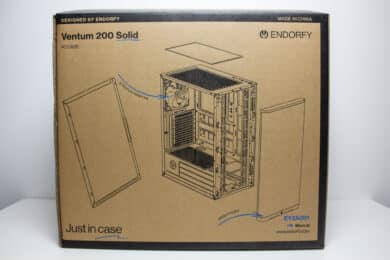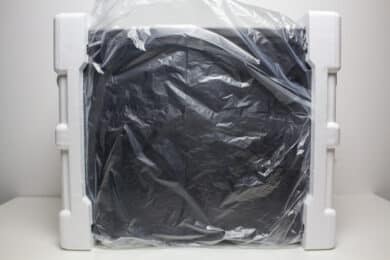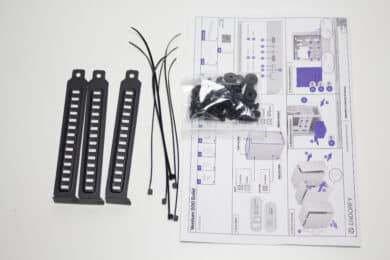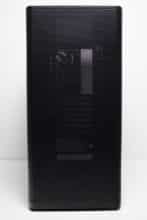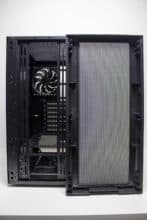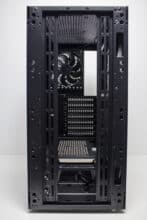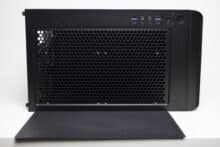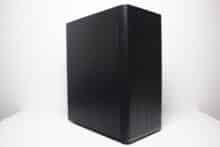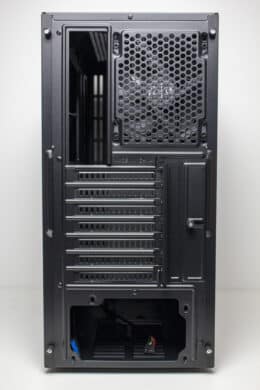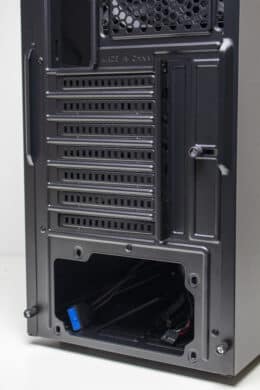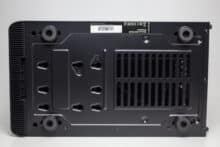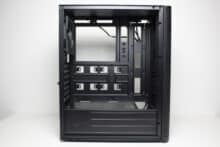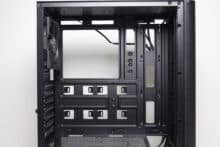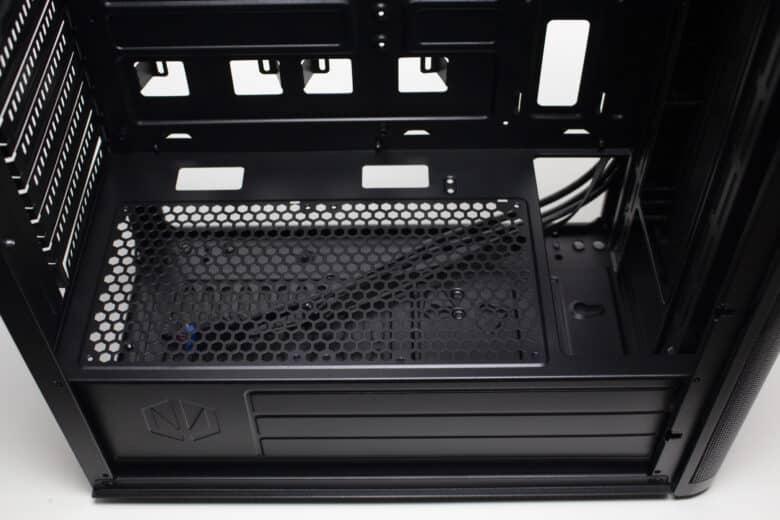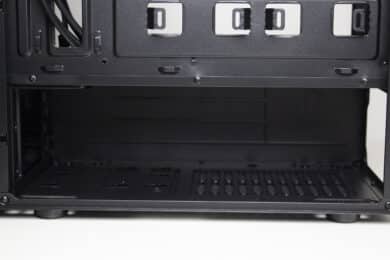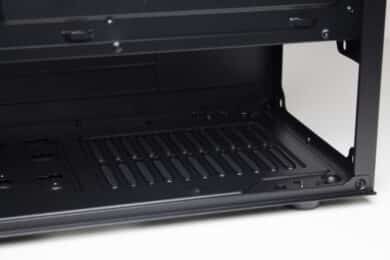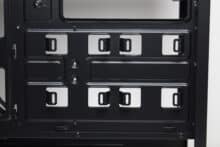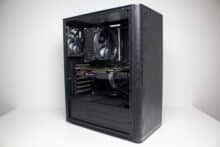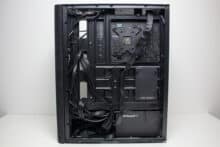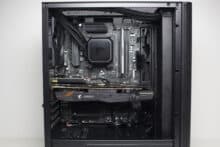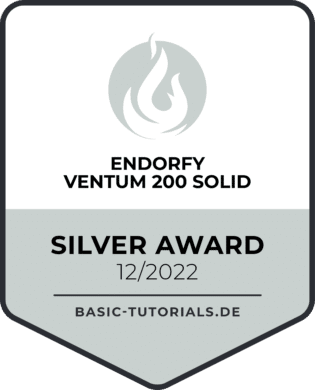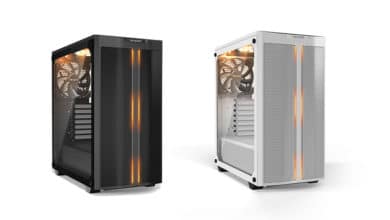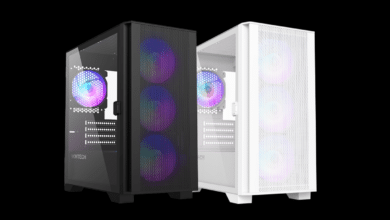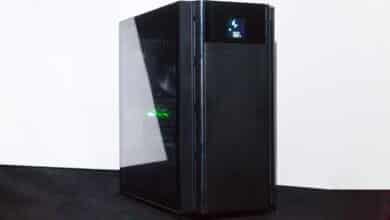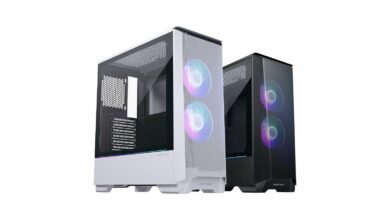
The former SilentiumPC brand is hidden behind the ENDORFY brand. It was founded in Warsaw, Poland in 2007 and initially focused only on PC components in the field of cases and cooling. However, since the portfolio has since been expanded to include various computer accessories of different categories (mouse, keyboard, headsets, etc.), the manufacturer has made the decision to change the name from SilentiumPC to ENDORFY. However, the main focus in the development of new products remains unchanged: good value, good features and solid workmanship. Today we are going to test the compact midi tower ENDORFY Ventum 200.
In line with the brand name, all products have also undergone a freshening up. The ENDORFY Ventum 200 is the successor of the SilentiumPC Ventum VT2 and the smallest and cheapest offspring of the case range. The Ventum 200 is supposed to convince with a low price and a high airflow potential. ENDORFY offers the Ventum 200 in two versions. The cheaper “Solid” version comes with two steel side panels and one fan, while the more expensive “Air” version comes with a glass side window and four Stratus fans. Price-wise, it starts at € 46.99 *.
Technical details
| Model: | ENDORFY Ventum 200 Solid |
| Case Type: | ATX |
| Dimensions: | 211 mm (W) x 440 mm (H) x 373 mm (D) |
| Weight: | 3.45 kg |
| Material: | Steel, plastic |
| Color: | Black |
| Front connectors | 2x USB 3.0 Type-A, 1x HD audio |
| Drive bays: | 1x 3.5″/ 2.5″ 2x 2.5″ |
| Expansion slots: | 7x horizontal |
| Form Factors: | ATX, mATX, ITX |
| Ventilation: | Front: 3x 120/ 2x 140 mm Rear: 1x 120 mm Lid: 2x 120 mm Bottom: 2x 120 mm |
| Radiators: | Front: 1x 240/ 280/ 360 mm Rear: 1x 120 mm Lid: 1x 240 mm |
| Max. CPU cooler height: | 161 mm |
| Max. Graphics card length: | 315 mm |
| Max. Net part length: | 180 mm (with HDD cage) |
| Cable management space: | 20 – 25 mm |
| Price: | € 46.99 * |
| Features: | Dust filter, cable management |
ENDORFY Ventum 200 review: the scope of delivery
ENDORFY packaged the Ventum 200 in a simple brown cardboard box with black and blue accents. Printed on it are a drawing of the midi tower and a table with all the technical specifications. Also printed on the cardboard are the main features of the tower in black color. Inside the box, ENDORFY wraps the Ventum 200 with two blocks of hard Styrofoam as well as a plastic film. Since the case is not really heavy at 3.45 kilograms, the packaging should be able to sufficiently prevent damage during transport or shipping.
The manufacturer stows the included accessories in a plastic bag. It contains all the screws necessary for mounting the components, an installation guide, three PCI slot bezels and some cable ties. Also included are two magnetic dust filters for the bottom and top panels and a pre-installed Stratus 120 PWM fan.
Exterior impression
Basically, ENDORFY has not changed the Ventum 200 compared to the VT2. The appearance is identical and the dimensions have only been adjusted by one millimeter in height and depth. The front still consists of a large mesh grille, which is rounded at the corners and surrounded by a plastic frame at the top and bottom. The manufacturer’s logo has also been pressed into the plastic frame in the lower area. There is no additional dust filter behind the grille. The front panel can be removed with a strong jerk, revealing two mounting rails. These are supposed to be used for mounting radiators or fans. A maximum of three 120 mm fans or a 360 mm radiator can be attached here.
The lid has a similar airy design as the front. Thus, there is a large fan grille here as well, which can be used to mount two 120mm fans. A magnetic dust filter has also been placed above the grille for dust protection and to improve the appearance. Finally, you can find the elongated I/O panel in the lid, which is oriented on the right side. It has two USB 3.0 Type-A ports, an HD audio combo port and two buttons for power and reset.
In the “Solid” version, both side panels are made of steel. They have two thumbscrews each, as well as an extraction aid. The stability of the panels is rather below average. This is probably a consequence of the lower purchase price. Despite the low weight, the body remains quite stable even without the side panels.
The rear panel has been designed in an unexciting way and does not reveal any special features. The power supply is mounted at the bottom and above it there are seven non-reusable PCI slot ends, whose screwing is done outside the case. Lastly, we find a mounting spot for a 120mm fan at the rear. This space is already equipped with an ENDORFY Stratus 120 PWM fan in our variant.
The Ventum 200 gets a secure stand via four stable feet made of plastic, which were attached to the bottom of the midi tower. In addition, the feet have been covered with a layer of foam rubber, which should prevent vibration transmission and scratches on the floor. ENDORFY has also given the feet a glossy layer of aluminum-look plastic. The large ventilation opening for the power supply as well as the entire base are covered by a magnetic dust filter that can be easily removed for cleaning.
Interior impression
The interior of the Ventum 200 is basically divided into two chambers. The large main chamber has room for the motherboard, a long graphics card, and various fans or radiators. It is designed to fit graphics cards up to 315 millimeters long despite the short body. However, this value only applies if no radiator is installed in the front. Furthermore, seven cable management openings have been cut into the motherboard tray around the mainboard. The optional front fans can transport air unhindered into the interior due to the lack of HDD frames.
In the lower area you’ll find a typical power supply cover, which hides the view of the power supply and the possible tangle of cables. A perforation on the top allows the PSU to be mounted with the fan facing up, if desired. The cover also has eight holes for elongated screws, which can be used to screw on up to two 120 mm fans. Apart from that, ENDORFY has equipped the cover with a few openings for cables as well as a cutout for a front radiator.
An ATX power supply and a 3.5″ or 2.5″ HDD can be attached underneath the cover. However, the PSU only rests undecoupled on four steel plateaus. Apart from that, the back of the motherboard tray offers all relevant features for mounting data carriers or laying or stowing cables. There is about 20 millimeters of space for cables and there are also eyelets for cable ties.
As already mentioned, there is room for up to three data carriers in the Ventum 200. Two 2.5″ data storage devices can be attached to the mainboard tray behind the mainboard and one 3.5″ or 2.5″ HDD in front of the PSU. However, depending on the length of the PSU, this mounting spot can also be blocked. The mounting is always done with screws, but is partially decoupled for this.
Overall, the exterior and interior workmanship of the ENDORFY is okay, or rather corresponds to the fairly low price range. During the review, we did not find any sharp edges that you could cut yourself on. However, there were some spots on the inside of the side panels that were not completely painted. You also quickly notice that material thickness was saved in some areas to save costs.
ENDORFY Ventum 200 Solid Test: Installation of the Components
Now we come to the system installation for the ENDORFY Ventum 200 Solid Test. For hardware, we’re using a AMD Ryzen 5 1400 on a MSI B350 PC Mate with 16GB Crucial Ballistix Sport LT gray DDR4-2666. The Ryzen is cooled by an LC-Power Cosmo Cool LC-CC-120-RGB and is overclocked to 3.8 GHz (1.25 V). A GTX 1060 6GB from Gigabyte AORUS is responsible for the image output. The power supply is handled by the fully modular LC-Power LC550 V2.31 Platinum with an 80 Plus Platinum efficiency rating.
Installation and wiring of all components was quickly completed and a breeze. Despite the fairly small dimensions of the midi tower, there was plenty of room for mounting due to the large main chamber. Also helpful were the, at least partially, pre-installed spacers for the motherboard. For the remaining three stand-offs, ENDORFY has kindly included an attachment for a screwdriver in the accessories. Finally, the mainboard tray has enough openings so that a clean cabling of the system was possible. Finally, a few impressions of the assembled test system.
The general hardware compatibility of the Ventum 200 is okay, but not outstanding either. With a maximum height for CPU coolers of 161 millimeters and a maximum length of 315 millimeters for graphics cards, certain limitations have to be accepted in terms of component selection. There is a maximum of 180 millimeters of space for the power supply with the HDD mounted. Furthermore, two radiators can be accommodated within the midi tower at the same time. A front radiator then of course further restricts the maximum possible graphics card length.
The ENDORFY Ventum 200 comes with a pre-installed Stratus 120 PWM case fan ex-works. This is completely black and rotates with a maximum of 1500 revolutions per minute. It is connected via a black 4-pin PWM cable.
Finally, we come to the temperatures that were reached in the ENDORFY Ventum 200 Solid. During the stress test, Prime95 and FurMark were run for 15 minutes at a room temperature of 20 °C. Furthermore, the test was performed with two different fan speeds and with additional front fans, respectively.
Scenario |
Temperature |
| CPU: 50% PWM (950rpm) GPU: 50% PWM (1650 rpm) Open-air benchtable (no additional fans) |
CPU: 65.1 °C GPU: 58.2 °C |
| CPU: 50% PWM (950 rpm) GPU: 50% PWM (1650 rpm) 1x 120 mm 50% PWM ( 925 rpm) |
CPU: 73.8 °C GPU: 65.9 °C |
| CPU: 50% PWM (950 rpm) GPU: 50% PWM (1650 rpm) 1x 120 mm 100% PWM (1450 rpm) |
CPU: 68.8 °C GPU: 63.9 °C |
| CPU: 50% PWM (950 rpm) GPU: 50% PWM (1650 rpm) 4x 120 mm 50% PWM ( 925 rpm, 1150 rpm ) |
CPU: 65.5 °C GPU: 61.6 °C |
| CPU: 50% PWM (950 rpm) GPU: 50% PWM (1650 rpm) 4x 120 mm 50% PWM ( 1450 rpm, 1800 rpm) |
CPU: 62 °C GPU: 59.5 °C |
The fact that the ENDORFY Ventum 200 is an airy case is already noticeable when only the standard fan is used. This moves enough air to sufficiently cool the processor and graphics card. If you add two or three more fans in the front, the maximum temperature of the CPU is visibly reduced. In terms of cooling, there are no complaints with the ENDORFY Ventum 200.
ENDORFY Ventum 200 Solid Test: Conclusion
Basically, we are always quite skeptical about a low-priced case with low weight before the test. This skepticism was also justified in parts this time. But let’s start with the positive things. ENDORFY has developed a rock-solid case with the Ventum 200, which has some positive features and at the same time does not break the wallet. Despite the compact dimensions, it offers enough space for hardware and also has a good airflow potential through the mesh front to be able to cool the installed hardware. This overall package is rounded off by an unobtrusive appearance and the existence of another variant with a viewing window. So the buyer has the choice.
Basically, you also notice that the Ventum 200 is a case in the budget segment. For example, the total weight of 3.5 kilograms is not that high and the material thickness is correspondingly lower at one point or another. Furthermore, the quality of the paintwork was borderline in places. The mounting of the side panels and the compatibility with only three data carriers could also deter one or the other buyer.
The price of € 46.99 * has increased by about €10 compared to the predecessor VT2. Considering inflation and increased transportation costs, that seems okay for now. Nevertheless, there are cases with similar build quality as well as features that can already be had for 34€. Especially if RGB and a side window are relevant for the purchase, the Ventum 200 Solid will probably lose out. However, if you are looking for a cheap and simple midi tower, you should basically find what you are looking for with the ENDORFY Ventum 200. However, one should not expect miracles from the Ventum 200.
ENDORFY Ventum 200 Solid
Workmanship
Structure
Features
Cooling
Value for money
80/100
The ENDORFY Ventum 200 Solid is a rock-solid midi tower that convinces with its compact dimensions and with a good hardware compatibility as well as the sleek look and a good airflow potential. However, the low material thickness and the at most average build quality in places tarnish the overall result.



